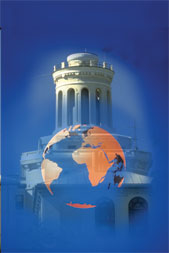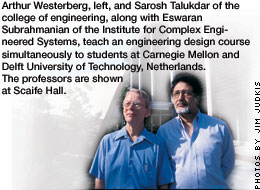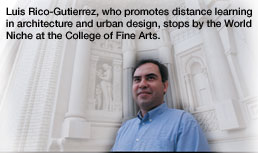|
|
||||
|
|
Technology Links Students Around the World �
Striving to provide students with a global learning environment, Carnegie Mellon uses various forms of Technology Enhanced Learning (TEL) in its efforts to link Carnegie Mellon students with students around the world.
"Internationalization is a vital component of Carnegie Mellon's strategic plan," said Paul Goodman, director of the university's Institute for Strategic Development and professor of organizational psychology in the business school. "We want to find novel ways to create learning environments that will help our students operate in a global setting." As businesses and corporations continue to become increasingly decentralized, the demand for professionals capable of performing in the international arena continues to rise. While studying abroad provides students with an opportunity to interact with students from other cultures, Carnegie Mellon's challenging curriculum often restricts students from doing so. However, through classes such as "Engineering Design Problem Foundation," "Management Game," "Ethical Judgment and Professional Life," "Artists and their Museums on the Riviera," and an architecture studio, TEL programs give Carnegie Mellon students real-time global experience without leaving campus.
In "Engineering Design Problem Foundation," an undergraduate course taught by Chemical Engineering Professor Arthur Westerberg, Carnegie Mellon students work in four-person "virtual teams" with students at Delft University in the Netherlands to study problem formulation in complex environments. The "interactive" video environment uses video lecture as a stimulus for discussion. Through videoconferencing, e-mail, and a specially designed Web-based document system, two students in the Netherlands and two students from Carnegie Mellon work together on a major design problem, such as the design of a water/sewage system.
In "Ethical Judgment and Professional Life," taught by Philosophy Professor Peter Madsen, Carnegie Mellon undergraduate students and students at Mexico's ITESM (Instituto Tecnologico y de Estudios Superiores de Monterrey) identify and evaluate community values. Through the course Web site, students respond to each of 14 ethical dilemmas, post essays, and comment on each other's work. This stream of commentaries enables students to share their different perspectives on the problem. Several times throughout the semester, videoconferences allow students from both countries to come together at the same time. "Artists and Their Museums on the Riviera," taught by Barbara Freed, professor of French and applied linguistics, introduces students to artists such as Picasso and Matisse. Through an interactive videoconference, students visit some of the Riviera's museums. Students are able to ask museum directors questions about the role of the museum, its goals and its audience.
Students in Luis Rico-Gutierrez's architecture studio use computer technology and telecommunications to work jointly on projects with students at Mexico's ITESM. The students use videoconferencing between Pittsburgh and Monterrey to give each other feedback while using e-mail, faxes, and Web-based tools to communicate asynchronously. By focusing on sharing real, concrete projects across countries, the students actively learn about similarities and differences between architectural approaches in the two countries.
Carnegie Mellon's Institute for Strategic Development, the organizational unit responsible for facilitating international activities across the university, has received grants from the U.S. Department of Education, the Ford Foundation, and the Hewlett Foundation to foster technology enhanced learning on an international scale. The university's work has not gone unnoticed. In May, Carnegie Mellon was one of only six institutions nationwide to receive an ACE/AT&T Award for Technology as a Tool for Internationalization. The award, which recognizes the innovative use of technology to promote international learning, carries with it a grant of $7,500. Carnegie Mellon also recently received the Institute for International Education's 2003 Andrew Heiskell Award for Technology Enhanced Learning in International Education in the category of Special Presidential Recognition. The IIE praised Carnegie Mellon for "innovative use of technology to increase global understanding and global problem-solving skills for undergraduates, with a focus on students who cannot go abroad for financial or curriculum reasons."
Bethany Elder
|
||
|
Carnegie Mellon Home |
||||
 Using a combination of videoconferencing, course management Web sites, e-mail, and meeting software, these TEL programs enable students to work with students in other countries on a "real time" basis. Carnegie Mellon currently implements many diverse models of international learning environments. These models are used for courses in a variety of disciplines, including engineering, architecture, business, ethics and art.
Using a combination of videoconferencing, course management Web sites, e-mail, and meeting software, these TEL programs enable students to work with students in other countries on a "real time" basis. Carnegie Mellon currently implements many diverse models of international learning environments. These models are used for courses in a variety of disciplines, including engineering, architecture, business, ethics and art.
 "Management Game," an MBA course coordinated by Senior Lecturer David Lamont, requires teams of students to act as senior managers of simulated manufacturing companies. Each team, reporting to a Board of Directors composed of business people, defends its business plan and results to the board, which then give feedback and evaluates the team's performance. The most recent class session included more than 90 teams from business schools in Argentina, Chile, China, Japan and Ukraine.
"Management Game," an MBA course coordinated by Senior Lecturer David Lamont, requires teams of students to act as senior managers of simulated manufacturing companies. Each team, reporting to a Board of Directors composed of business people, defends its business plan and results to the board, which then give feedback and evaluates the team's performance. The most recent class session included more than 90 teams from business schools in Argentina, Chile, China, Japan and Ukraine.
 Because virtual international exchange remains in its early stages, those involved with the TEL program experience many challenges. Goodman said one major challenge is getting more professors interested in providing students with a global experience and then selecting a model for them to incorporate global interaction within the context of
their course.
Because virtual international exchange remains in its early stages, those involved with the TEL program experience many challenges. Goodman said one major challenge is getting more professors interested in providing students with a global experience and then selecting a model for them to incorporate global interaction within the context of
their course.